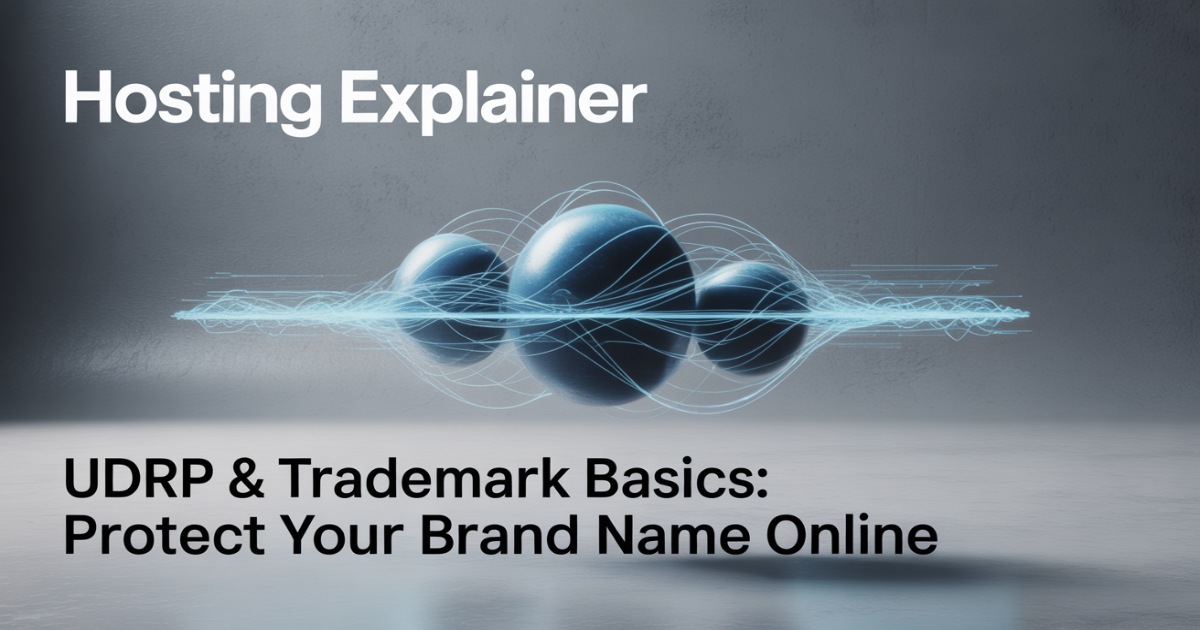UDRP & Trademark Basics: Protect Your Brand Name Online
If you’ve ever seen your brand name used in someone else’s domain, you know the mix of frustration and worry it brings. Years ago, I helped a small business owner recover a domain that matched their brand. It was registered by someone overseas who demanded money to give it back. That’s when I first learned how the UDRP process protects brands from bad-faith domain registrations.
In this guide, I’ll walk you through how UDRP and trademark protection work together to secure your brand name online, how to file a case if needed, and what steps to take to stay ahead of cybersquatters.
What Is UDRP, and Why It Matters for Brand Owners
UDRP (Uniform Domain-Name Dispute-Resolution Policy) is a global process created by ICANN to resolve domain name disputes without going to court. It’s used when someone registers a domain that’s identical or confusingly similar to your trademark or brand name, usually in bad faith.
UDRP gives trademark owners a faster, less expensive way to recover domains compared to traditional litigation. It’s handled by approved providers like WIPO (World Intellectual Property Organization) or the National Arbitration Forum.
If you own a trademark and find that someone is using your brand name in a domain to mislead, profit, or impersonate your business, the UDRP process can help you take it back.

Understanding Trademark Protection in the Digital Age
Your trademark is your brand’s legal identity. Online, it’s often tied to domain names, logos, and social media handles. Trademarks protect your brand from others using similar names that could confuse your audience or damage your reputation.
Unfortunately, many scammers register brand-related domains before or after you do. This is called cybersquatting, registering domains in bad faith to sell, block, or misuse them. Even if you have a registered trademark, you need to actively defend it online.
A strong trademark plus proactive brand name protection measures keep your business safe from impersonation and lost web traffic.
How the UDRP Process Works
UDRP sounds complex, but it follows a clear four-step process. Here’s how it works.
Step 1—Filing a UDRP Complaint
To begin, you file a complaint with an approved UDRP provider such as WIPO. You must show three things:
- The domain name is identical or confusingly similar to your trademark.
- The registrant has no legitimate interest in the domain.
- The domain was registered and is being used in bad faith.
The filing fee usually ranges from $1,500 to $4,000, depending on the number of domains and panelists you choose.
Step 2—The Respondent’s Role
Once the case is filed, the domain owner (respondent) gets a notice and has 20 days to reply. They can defend themselves by proving they use the domain fairly or have rights to it. If they don’t respond, the panel often decides based on your evidence alone.
Step 3—The Decision Phase
A panel of one or three experts reviews the evidence. They check if the domain:
- Matches or closely resembles your trademark.
- Was registered without legitimate reason.
- Was used in bad faith (for example, to sell, mislead, or harm your brand).
This phase usually takes 2–3 weeks.
Step 4—Outcome and Domain Transfer
If you win, the domain is transferred to you. If not, the respondent keeps it. The whole process often takes about 45 to 60 days, much faster than going to court.
Proving Bad Faith in a Domain Dispute
The heart of every UDRP case is proving bad faith. This means showing that the person who registered the domain did it to profit from your brand or harm it.
Examples of bad faith include:
- Offering to sell the domain to you for a high price.
- Using the domain to redirect visitors to a competing site.
- Creating fake websites or phishing pages that imitate your brand.
Evidence helps. Save screenshots, emails, WHOIS data, and any correspondence that shows intent to mislead or profit unfairly. In my experience, clear proof of bad faith often makes or breaks a UDRP case.
Common UDRP Mistakes and How to Avoid Them
Many businesses lose UDRP cases not because they’re wrong, but because they make avoidable mistakes. Here are some of the biggest ones:
- Filing without a registered trademark or solid evidence of brand ownership.
- Submitting unclear or incomplete complaints.
- Waiting too long to take action.
- Missing response deadlines.
- Not choosing the right arbitration provider.
Take time to prepare before filing. If needed, work with a domain dispute specialist or IP attorney to strengthen your case.
Practical Tips to Protect Your Brand Name Online
UDRP is a great safety net, but prevention is even better. Here’s how to protect your brand before problems start:
- Register your trademark early in key regions.
- Buy multiple domain extensions (like .com, .net, and .org) to block impersonators.
- Use brand monitoring tools such as Google Alerts or NameWatch.
- Renew domains on time and lock them to prevent hijacking.
- Send a cease and desist letter before escalating to a UDRP complaint.
These small steps help you avoid the stress and cost of domain disputes later.
UDRP vs. Court Litigation: Which Is Better?
Many people ask whether they should go through UDRP or file a lawsuit. Both have pros and cons.
| Factor | UDRP | Court Litigation |
|---|---|---|
| Speed | 1–2 months | 6–12 months or more |
| Cost | $1,500–$4,000 | Can exceed $10,000 |
| Process | Online arbitration | Formal legal process |
| Outcome | Domain transfer or cancellation | Monetary damages possible |
| Best For | Clear cases of bad faith | Complex trademark disputes |
If you simply want your domain back, UDRP is faster and cheaper. If you need damages or face repeated infringement, court may be better.
How I Recovered a Domain Through UDRP
A few years back, I helped a client whose brand domain was taken by someone listing fake products. We filed a UDRP complaint through WIPO. We showed proof of their registered trademark, screenshots of the fake site, and emails from customers who were misled.
Within six weeks, the panel ruled in our favor. The domain was transferred, and the client’s site was restored. The lesson? Act fast, gather evidence, and don’t assume you have no recourse. The UDRP system works when you use it right.
- UDRP is a fair and quick way to resolve domain name disputes.
- You need a valid trademark and clear evidence of bad faith.
- Be proactive and protect your brand with monitoring and early domain registration.
- Use UDRP for clear-cut cases; consider court if damages or broader enforcement are needed.
- Always back your claims with proof.
- Your brand name is part of your identity. Guard it like you would your physical assets.
FAQs About UDRP and Online Trademark Protection
1. What does UDRP stand for?
UDRP means Uniform Domain-Name Dispute-Resolution Policy, a global system for resolving domain name conflicts outside of court.
2. How long does a UDRP case take?
Most cases take about 45–60 days from filing to decision.
3. Do I need a lawyer to file a UDRP complaint?
Not always. You can file it yourself, but hiring an expert helps avoid mistakes.
4. Can UDRP help if my domain was stolen?
Yes. If the domain was transferred or registered in bad faith, UDRP can help you recover it.
5. What’s the difference between UDRP and court action?
UDRP is faster and cheaper but limited to domain transfers. Courts can award damages but take longer.
6. Can small businesses afford UDRP cases?
Usually yes. Compared to lawsuits, UDRP is much more affordable and efficient.
Why Protecting Your Brand Name Online Matters More Than Ever
Protecting your brand name online isn’t optional anymore. The internet moves fast, and so do bad actors. Understanding UDRP and trademark basics gives you control and confidence.
Whether you’re a small startup or a global brand, take charge of your digital identity today, before someone else does. Every domain, trademark, and piece of content tied to your name is part of your reputation.
Guard it, monitor it, and act early when something feels off. Your brand is your story. Make sure you’re the one telling it, not someone pretending to be you.






